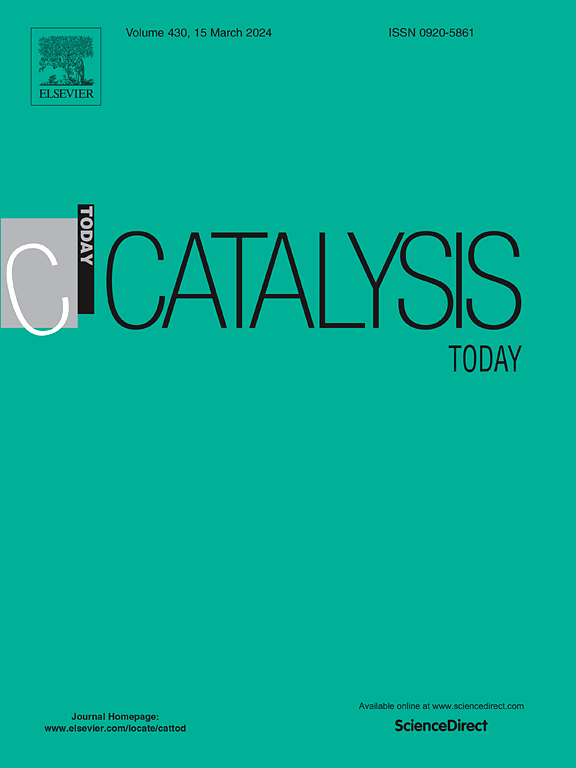富缺陷碳掺杂Mn3O4光热丙酮高效氧化两步热解工程
IF 5.2
2区 化学
Q1 CHEMISTRY, APPLIED
引用次数: 0
摘要
高效光热催化剂是光能有效利用和含氧挥发性有机化合物(OVOCs)低能耗催化氧化反应的关键。本文通过Mn-MIL-100在不同气氛下的两步煅烧工艺,成功合成了富缺陷掺杂碳的Mn3O4样品。其中,Mn3O4/C-N6A2表现出最优的性能,在全光谱模拟阳光下,CO2产率为91% %,丙酮转化率为92% %,并保持至少100 h的稳定性。高活性可能是由于碳的光热辅助性质,大量的氧空位和Mn3+活性位点的有益协同作用。此外,碳掺杂还可以通过增强Mn3O4的吸光能力、电荷传输效率和活性氧(ROS)的形成来改善其催化性能。此外,光驱动热催化、光活化和光催化共存,确保了高效和持续的光热催化丙酮氧化。此外,氧空位加速了气态氧的吸附和活化,促进了乙醛和羧酸盐等中间体深度氧化成CO2和H2O。因此,本研究为设计和制造高效的碳掺杂金属氧化物光热催化剂提供了一种创新的方法。本文章由计算机程序翻译,如有差异,请以英文原文为准。
Two-step pyrolytic engineering of carbon-doped Mn3O4 with rich defects for efficient photothermal acetone oxidation
Efficient photothermal catalysts are crucial for effective light energy utilization and low-energy-driven catalytic oxidation reaction of oxygenated volatile organic compounds (OVOCs). Herein, defect-rich carbon-doped Mn3O4 samples were successfully synthesized through a two-step calcination process of Mn-MIL-100 under various atmospheres. Among them, Mn3O4/C-N6A2 exhibited the optimal performance, achieving a 91 % CO2 yield and a 92 % acetone conversion under the entire spectrum simulated sunlight while maintaining stability for at least 100 h. The high activity can be due to the beneficial synergies of carbon's photothermal-assisted properties, numerous oxygen vacancies, and Mn3+ active sites. Additionally, carbon doping could also improve the catalytic performance of Mn3O4 by enhancing light-absorbing capacity, charge transmission efficiency, and reactive oxygen species (ROS) formation. Furthermore, light-driven thermocatalysis, photoactivation, and photocatalysis coexist, ensuring an efficient and sustained photothermal catalytic acetone oxidation. Besides, oxygen vacancies accelerated the adsorption and activation of gaseous oxygen and promoted intermediates such as acetaldehyde and carboxylate, deep oxidation into CO2 and H2O. Therefore, this study offers an innovative approach to designing and fabricating efficient carbon-doped metal oxide photothermal catalysts.
求助全文
通过发布文献求助,成功后即可免费获取论文全文。
去求助
来源期刊

Catalysis Today
化学-工程:化工
CiteScore
11.50
自引率
3.80%
发文量
573
审稿时长
2.9 months
期刊介绍:
Catalysis Today focuses on the rapid publication of original invited papers devoted to currently important topics in catalysis and related subjects. The journal only publishes special issues (Proposing a Catalysis Today Special Issue), each of which is supervised by Guest Editors who recruit individual papers and oversee the peer review process. Catalysis Today offers researchers in the field of catalysis in-depth overviews of topical issues.
Both fundamental and applied aspects of catalysis are covered. Subjects such as catalysis of immobilized organometallic and biocatalytic systems are welcome. Subjects related to catalysis such as experimental techniques, adsorption, process technology, synthesis, in situ characterization, computational, theoretical modeling, imaging and others are included if there is a clear relationship to catalysis.
 求助内容:
求助内容: 应助结果提醒方式:
应助结果提醒方式:


